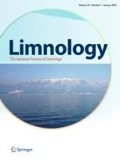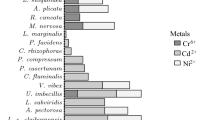Abstract
The golden mussel (Limnoperna fortunei) has caused worldwide problems for the eco-environment and man-made structures. There have been many control strategies proposed, which have various strengths and weaknesses. To help selection of the effective control strategies that consider the biological traits of L. fortunei and the actual situation of biofouling, we studied the ecological amplitudes that indicate the tolerance of the species to environmental conditions and propose appropriate strategies based on their ecological amplitudes. We set five levels for the environmental factors water temperature, dissolved oxygen concentration, pH and ammonium ion concentration and four levels for light intensity. The survival ratio and attachment ratio of golden mussels under the different environmental conditions were measured and the nonlinear regression models were used to simulate the ecological amplitudes of golden mussel. The results show that their ecological amplitudes are wide-ranging with respect to water temperature (13–29 °C), dissolved oxygen (> 1.5 mg/L), pH (4.1–8.7), ammonium ions concentration (lower 65 mg/L) and light intensity (0–55,000 l x) and the mussels show obvious negative phototaxis. Therefore, adjustment of the environment with high water temperatures, low dissolved oxygen, high pH values or strong and continuous light illumination is suggested as a potentially effective control strategy of golden mussel biofouling.





Similar content being viewed by others
References
Boltovskoy D (2015) Distribution and colonization of Limnoperna fortunei: special traits of an odd mussel. In: Boltovskoy D (ed) Limnoperna fortunei: the ecology, distribution and control of a swiftly spreading invasive fouling mussel. Springer, Cham, pp 301–311
Boltovskoy D, Correa N, Cataldo D, Sylvester F (2006) Dispersion and ecological impact of the invasive freshwater bivalve Limnoperna fortunei in the Río de la Plata Watershed and Beyond. Biol Invasions 8:947–963
Boltovskoy D, Karatayev A, Burlakova L, Cataldo D, Karatayev V, Sylvester F, Mariñelarena A (2009) Significant ecosystem-wide effects of the swiftly spreading invasive freshwater bivalve Limnoperna fortunei. Hydrobiologia 636:271–284
Boltovskoy D, Correa N, Sylvester F, Cataldo D (2015a) Nutrient recycling, phytoplankton grazing, and associated impacts of Limnoperna fortunei. In: Boltovskoy D (ed) Limnoperna fortunei: the ecology, distribution and control of a swiftly spreading invasive fouling mussel. Springer, Cham, pp 153–176
Boltovskoy D, Xu MZ, Nakano D (2015b) Impacts of Limnoperna fortunei on man-made structures and control strategies: general overview. In: Boltovskoy D (ed) Limnoperna fortunei: the ecology, distribution and control of a swiftly spreading invasive fouling mussel. Springer, Cham, pp 375–393
Claudi R, de Oliveira MD (2015) Chemical strategies for the control of the golden mussel (Limnoperna fortunei) in industrial facilities. In: Boltovskoy D (ed) Limnoperna fortunei: the ecology, distribution and control of a swiftly spreading invasive fouling mussel. Springer, Cham, pp 417–441
Crawley MJ (2007) The R book. Wiley, New York
Dalgaard P (2002) Introductory statistics with R. Springer, New York
Darrigran G, Damborenea C, Drago EC, de Drago IE, Paira A (2011) Environmental factors restrict the invasion process of Limnoperna fortunei (Mytilidae) in the neotropical region: a case study from the Andean tributaries. Ann Limnolo Int J Limnol 47:221–229
Darrigran G, Damborenea C, Drago EC, Ezcurra de Drago I, Paira A, Archuby F (2012) Invasion process of Limnoperna fortunei (Bivalvia: Mytilidae): the case of Uruguay River and emissaries of the Esteros del Iberá Wetland, Argentina. Zoologia 29:531–539
Duchini D, Boltovskoy D, Sylvester F (2015) Detachment, displacement and reattachment activity in a freshwater byssate mussel (Limnoperna fortunei): the effects of light, temperature and substratum orientation. Biofouling 31:599–611
Hawkins A, Bayne B (1985) Seasonal variation in the relative utilization of carbon and nitrogen by the mussel Mytilus edulis: budgets, conversion efficiencies and maintenance requirements. Mar Ecol Prog Ser 25:181–188
Hincks SS, Mackie GL (1997) Effects of pH, calcium, alkalinity, hardness, and chlorophyll on the survival, growth, and reproductive success of zebra mussel (Dreissena polymorpha) in Ontario lakes. Can J Fish Aquat Sci 54:2049–2057
Karatayev AY, Boltovskoy D, Padilla DK, Burlakova LE (2007a) The invasive bivalves Dreissena polymorpha and Limnoperna fortunei: parallels, contrasts, potential spread and invasion impacts. J Shellfish Res 26:205–213
Karatayev AY, Padilla DK, Minchin D, Boltovskoy D, Burlakova LE (2007b) Changes in global economies and trade: the potential spread of exotic freshwater bivalves. Biol Invasions 9:161–180
Karatayev AY, Boltovskoy D, Burlakova LE, Padilla DK (2015) Parallels and contrasts between Limnoperna fortunei and species of dreissena. In: Boltovskoy D (ed) Limnoperna fortunei: the ecology, distribution and control of a swiftly spreading invasive fouling mussel. Springer, Cham, pp 261–297
Lepš J, Šmilauer P (2003) Multivariate analysis of ecological data using CANOCO. Cambridge University Press, Cambridge
Li S, Chen Y, Gao Y, Xia Z, Zhan A (2019) Chemical oxidants affect byssus adhesion in the highly invasive fouling mussel Limnoperna fortunei. Sci Total Environ 646:1367–1375
Mackie GL, Claudi R (2009) Monitoring and control of macrofouling mollusks in fresh water systems. CRC Press, Boca Raton
Montresor LC, Miranda-Filho KC, Paglia A, Luz DMR, Araújo JM, Silva MJdS, Gerhard L, Martinez CB, Vidigal THDA (2013) Short-term toxicity of ammonia, sodium hydroxide and a commercial biocide to golden mussel Limnoperna fortunei (Dunker, 1857). Ecotoxicol Environ Saf 92:150–154
Morton B (1977) The population dynamics of Corbicula fluminea (Bivalvia: Corbiculacea) in Plover Cove Reservoir, Hong Kong. J Zool 181:21–42
Nakano D, Strayer DL (2014) Biofouling animals in fresh water: biology, impacts, and ecosystem engineering. Front Ecol Environ 12:167–175
Nakano D, Baba T, Endo N, Nagayama S, Fujinaga A, Uchida A, Shiragane A, Urabe M, Kobayashi T (2015) Invasion, dispersion, population persistence and ecological impacts of a freshwater mussel (Limnoperna fortunei) in the Honshu Island of Japan. Biol Invasions 17:743–759
O’Neill C (1995) Control of zebra mussels in residential water systems. Sea Grant Institute, New York
Oksanen J, Blanchet FG, Friendly M, Kindt R, Legendre P, McGlinn D, Minchin PR, O'Hara RB, Simpson GL, Solymos P, Stevens MHH, Szoecs E, Wagner H (2018) Vegan: community ecology package
Oliveira MD, Hamilton SK, Calheiros DF, Jacobi CM (2010) Oxygen depletion events control the invasive golden mussel (Limnoperna fortunei) in a Tropical floodplain. Wetlands 30:705–716
Oliveira MD, Campos MCS, Paolucci EM, Mansur MCD, Hamilton SK (2015) Colonization and spread of Limnoperna fortunei in South America. In: Boltovskoy D (ed) Limnoperna fortunei: the ecology, distribution and control of a swiftly spreading invasive fouling mussel. Springer, Cham, pp 333–355
Paine CET, Marthews TR, Vogt DR, Purves D, Rees M, Hector A, Turnbull LA (2012) How to fit nonlinear plant growth models and calculate growth rates: an update for ecologists. Methods Ecol Evol 3:245–256
Perepelizin PV, Boltovskoy D (2011) Hot water treatment (chronic upper lethal temperature) mitigates biofouling by the invasive Asian mussel Limnoperna fortunei in industrial installations. Environ Sci Technol 45:7868–7873
Perepelizin PV, Boltovskoy D (2014) Effects of 254 nm UV irradiation on the mobility and survival of larvae of the invasive fouling mussel Limnoperna fortunei. Biofouling 30:197–202
Perepelizin PV, Boltovskoy D (2015) Control of Limnoperna fortunei fouling by oxygen deprivation. In: Boltovskoy D (ed) Limnoperna Fortunei: the ecology, distribution and control of a swiftly spreading invasive fouling mussel. Springer, Cham, pp 451–454
Perez M, García M, Traversa L, Stupak M (2003) Concrete deterioration by golden mussels. In: RILEM international conference on microbial impact on building materials, pp 39–47. RILEM Publications SARL
Ricciardi A (1998) Global range expansion of the Asian mussel Limnoperna fortunei (Mytilidae): another fouling threat to freshwater systems. Biofouling 13:97–106
Selin NI, Vekhova EE (2004) Effects of environmental factors on byssal thread formation in some members of the family Mytilidae from the sea of Japan. Russ J Mar Biol 30:306–313
Uryu Y, Iwasaki K, Hinoue M (1996) Laboratory experiments on behaviour and movement of a freshwater mussel, Limnoperna fortunei (Dunker). J Molluscan Stud 62:327–341
Xu MZ (2015) Distribution and spread of Limnoperna fortunei in China. In: Boltovskoy D (ed) Limnoperna Fortunei: the ecology, distribution and control of a swiftly spreading invasive fouling mussel. Springer, Cham, pp 313–320
Xu MZ, Wang ZY, Duan XH, Zhuang MQ, Souza FTD (2009) Ecological measures of controlling invasion of golden mussel (Limnoperna fortunei) in water transfer systemsn water transfer systems. Water Engineering for A Sustainable Environment, In Iahr Congress
Xu MZ, Darrigran G, Wang ZY, Zhao N, Lin CC, Pan BZ (2015) Experimental study on control of Limnoperna fortunei biofouling in water transfer tunnels. J Hydro Environ Res 9:248–258
Zhang JH, Xu MZ (2020) Modelling the effects of water transfer project on distribution of Golden Mussel in China. In: 13th international symposium on ecohydraulics. Lyon, France. (Accepted abstract)
Zhang CD, Xu MZ, Wang ZY, Liu W, Yu DD (2017) Experimental study on the effect of turbulence in pipelines on the mortality of Limnoperna fortunei veligers. Ecol Eng 109:101–118
Zhao N, Xu M, Blanckaert K, Qiao C, Zhou H, Niu X (2019) Study of factors influencing the invasion of Golden Mussels (Limnoperna fortune) in water transfer projects. Aquat Ecosyst Health Manag. https://doi.org/10.1080/14634988.2019.1698860
Zhou HD, Peng QZ, Du X, Huang HJ (2004) Assessment of surface water quality in China. Journal of China Institute of Water Resources and Hydropower Research, 21–30. (in Chinese with English abstract)
Acknowledgements
We are grateful to the managers from the East River Water Source Project (ERWSP) and the Xizhijiang Pump Station for support our research, especially thanks to Mr. Yonghua Li, and Ms. Li Chen who have been providing support in our field investigations and experiments since 2008.
Funding
The study was financially supported by the National Science Fund China (Grant Nos. 91547204, 51779120), State Key Laboratory of Hydroscience and Engineering Project (2019-KY-01), Tsinghua University Project (2015THZ02-1).
Author information
Authors and Affiliations
Contributions
The study was conceived and designed by MX. Material preparation, data collection and analysis were performed by WL, JZ and TZ. The first draft of the manuscript was written by WL; MX revised the previous version and contributed to writing of this revision. All authors read and approved the final manuscript.
Corresponding author
Ethics declarations
Conflict of interest
The authors declare that they have no conflict of interest.
Additional information
Handling Editor: Yuichi Iwasaki.
Publisher's Note
Springer Nature remains neutral with regard to jurisdictional claims in published maps and institutional affiliations.
Electronic supplementary material
Below is the link to the electronic supplementary material.
Rights and permissions
About this article
Cite this article
Liu, W., Xu, M., Zhang, J. et al. Survival and attachment of biofouling freshwater mussel (Limnoperna fortunei) to environmental conditions: potential implications in its invasion, infection and biofouling control. Limnology 21, 245–255 (2020). https://doi.org/10.1007/s10201-020-00607-1
Received:
Accepted:
Published:
Issue Date:
DOI: https://doi.org/10.1007/s10201-020-00607-1




